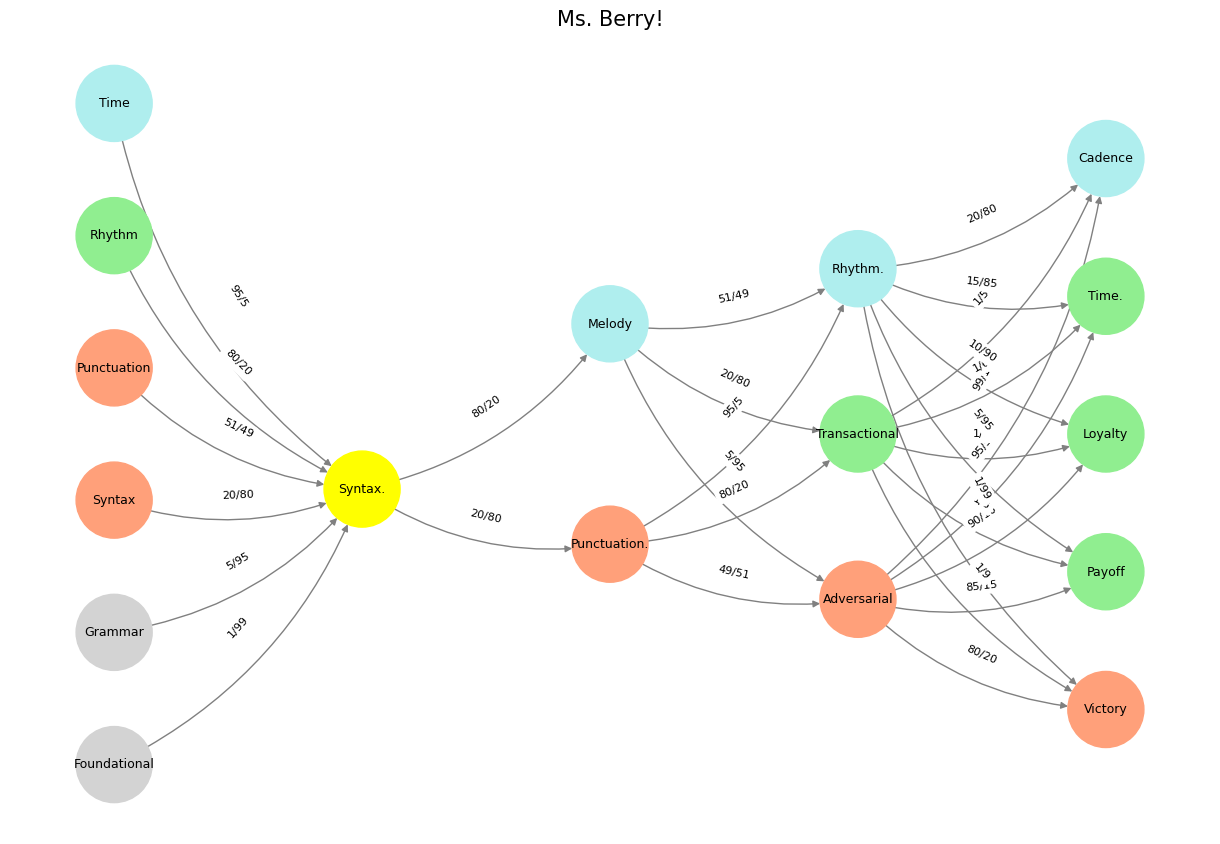Ecosystem#
Halle Berry’s recent project on menopause and longevity signals a shift in cultural discourse, emphasizing the rhythm of life stages and the need for structured yet fluid transitions. Her experience, described as “jaw-dropping,” suggests an epiphany—one that reframes how aging and change are discussed, particularly for women. This revelation aligns with a broader conceptualization of rhythm not only in music or speech but also in personal and biological narratives. Just as rhythm governs melody and cadence in music, it also structures human experiences, marking the passage of time with punctuation, pauses, and unexpected accelerations.
The neural network framework provided below captures this interplay between foundational structures and the unpredictable variations that emerge over time. In Berry’s case, her newfound purpose reflects a shift from one equilibrium to another—much like how adversarial elements in a system eventually transition into transactional and rhythmic patterns before reaching resolution. The network’s design, with nodes such as “Rhythm,” “Punctuation,” “Syntax,” and “Cadence,” mirrors the way personal experiences are encoded into habitual frameworks, disrupted by moments of adversity, and ultimately synthesized into wisdom. The inclusion of time as a key variable in multiple layers underscores how longevity, both as a biological and narrative construct, is shaped by the pacing of transitions rather than static states.

Fig. 6 Deviens: To Deviate From the Group & Become One’s Own. Indeed, deviens (from the French verb devenir, “to become”) and deviating share a common Latin root: venire, meaning “to come.” Etymological Breakdown: 1. Devenir (deviens, 2nd-person singular present tense) From Latin devenire (“to come down, arrive at”), composed of: de- (“down, away, from”)venire (“to come”) 2. Deviate From Latin deviāre (“to turn aside, wander”), composed of: de- (“away, off”) via (“way, path”). Shared Concept: Both words imply movement away from a prior state or direction: Deviens (devenir) → Becoming something different, emerging as one’s own. Deviate (dévier) → Straying from an expected path, diverging from the group. Thematic Connection: This suggests that becoming (devenir) contains an implicit divergence from the collective, an individuation. To become oneself may require a deviation from predefined paths—so the journey of devenir might inherently include dévier at key junctures.#
In music, rhythm is rarely a simple repetition; it bends, stretches, and syncopates, adding tension and unpredictability before returning to a structured pulse. Berry’s emphasis on menopause as a new frontier of self-discovery mirrors this principle—what was once dismissed as a biological inevitability is now being reframed as a space for agency, rhythm, and renegotiation of identity. In this sense, menopause, like rhythm, is not merely an endpoint but a dynamic interplay of movement and pause, of disruption and synthesis.
The neural network’s weighted edges suggest that certain transitions are easier than others. Syntax connects foundational elements with adversarial disruptions at varying probabilities, just as life events shift a person’s trajectory in ways that are not entirely linear. The placement of rhythm within both transactional and adversarial layers highlights its dual nature: it can be a stabilizing force, allowing for Melody to form, or a disruptive one, forcing recalibration. Berry’s engagement with this conversation suggests that she is challenging the notion of menopause as an endpoint, instead viewing it as a rhythmic shift—an opportunity to establish new cadences in both health and personal expression.
At a fundamental level, the discussion of rhythm—whether in music, speech, or personal transformation—hinges on the ability to anticipate and adapt. If menopause is a syncopated beat in the score of a woman’s life, then Berry’s project aims to provide the tools to navigate that shift with confidence, much like a musician learning to improvise within an established framework. The balance between structure and fluidity is crucial; too rigid a rhythm leads to stagnation, while too much variation results in disorientation. What Berry seems to advocate is a kind of rhythmic literacy, a way of understanding the fluctuations of time and biology as part of a larger, evolving composition.
The visualization of neural layers—foundational, grammatical, adversarial, and victorious—mirrors the way Berry’s project seeks to restructure cultural narratives around aging. The movement from punctuation to cadence suggests a progression from isolated disruptions to a more cohesive rhythm, much like the way a well-crafted sentence uses pauses and stresses to guide interpretation. In this sense, menopause, as Berry presents it, is not just an individual experience but a linguistic and rhythmic event, one that needs a grammar of its own.
In the end, what emerges is an understanding of rhythm as a fundamental principle not just in music but in life itself. Whether in the neural layers of cognition, the biological rhythms of aging, or the cultural narratives Berry seeks to reshape, rhythm dictates movement and meaning. It structures the transitions that define human experience, ensuring that even the most unexpected beats can eventually find their place in the larger composition.
Show code cell source
import numpy as np
import matplotlib.pyplot as plt
import networkx as nx
# Define the neural network layers
def define_layers():
return {
'Suis': ['Foundational', 'Grammar', 'Syntax', 'Punctuation', "Rhythm", 'Time'], # Static
'Voir': ['Syntax.'],
'Choisis': ['Punctuation.', 'Melody'],
'Deviens': ['Adversarial', 'Transactional', 'Rhythm.'],
"M'èléve": ['Victory', 'Payoff', 'Loyalty', 'Time.', 'Cadence']
}
# Assign colors to nodes
def assign_colors():
color_map = {
'yellow': ['Syntax.'],
'paleturquoise': ['Time', 'Melody', 'Rhythm.', 'Cadence'],
'lightgreen': ["Rhythm", 'Transactional', 'Payoff', 'Time.', 'Loyalty'],
'lightsalmon': ['Syntax', 'Punctuation', 'Punctuation.', 'Adversarial', 'Victory'],
}
return {node: color for color, nodes in color_map.items() for node in nodes}
# Define edge weights (hardcoded for editing)
def define_edges():
return {
('Foundational', 'Syntax.'): '1/99',
('Grammar', 'Syntax.'): '5/95',
('Syntax', 'Syntax.'): '20/80',
('Punctuation', 'Syntax.'): '51/49',
("Rhythm", 'Syntax.'): '80/20',
('Time', 'Syntax.'): '95/5',
('Syntax.', 'Punctuation.'): '20/80',
('Syntax.', 'Melody'): '80/20',
('Punctuation.', 'Adversarial'): '49/51',
('Punctuation.', 'Transactional'): '80/20',
('Punctuation.', 'Rhythm.'): '95/5',
('Melody', 'Adversarial'): '5/95',
('Melody', 'Transactional'): '20/80',
('Melody', 'Rhythm.'): '51/49',
('Adversarial', 'Victory'): '80/20',
('Adversarial', 'Payoff'): '85/15',
('Adversarial', 'Loyalty'): '90/10',
('Adversarial', 'Time.'): '95/5',
('Adversarial', 'Cadence'): '99/1',
('Transactional', 'Victory'): '1/9',
('Transactional', 'Payoff'): '1/8',
('Transactional', 'Loyalty'): '1/7',
('Transactional', 'Time.'): '1/6',
('Transactional', 'Cadence'): '1/5',
('Rhythm.', 'Victory'): '1/99',
('Rhythm.', 'Payoff'): '5/95',
('Rhythm.', 'Loyalty'): '10/90',
('Rhythm.', 'Time.'): '15/85',
('Rhythm.', 'Cadence'): '20/80'
}
# Calculate positions for nodes
def calculate_positions(layer, x_offset):
y_positions = np.linspace(-len(layer) / 2, len(layer) / 2, len(layer))
return [(x_offset, y) for y in y_positions]
# Create and visualize the neural network graph
def visualize_nn():
layers = define_layers()
colors = assign_colors()
edges = define_edges()
G = nx.DiGraph()
pos = {}
node_colors = []
# Add nodes and assign positions
for i, (layer_name, nodes) in enumerate(layers.items()):
positions = calculate_positions(nodes, x_offset=i * 2)
for node, position in zip(nodes, positions):
G.add_node(node, layer=layer_name)
pos[node] = position
node_colors.append(colors.get(node, 'lightgray'))
# Add edges with weights
for (source, target), weight in edges.items():
if source in G.nodes and target in G.nodes:
G.add_edge(source, target, weight=weight)
# Draw the graph
plt.figure(figsize=(12, 8))
edges_labels = {(u, v): d["weight"] for u, v, d in G.edges(data=True)}
nx.draw(
G, pos, with_labels=True, node_color=node_colors, edge_color='gray',
node_size=3000, font_size=9, connectionstyle="arc3,rad=0.2"
)
nx.draw_networkx_edge_labels(G, pos, edge_labels=edges_labels, font_size=8)
plt.title("Ms. Berry!", fontsize=15)
plt.show()
# Run the visualization
visualize_nn()


Fig. 7 For the eyes of the Lord run to and fro throughout the whole earth, to shew himself strong in the behalf of them whose heart is perfect toward him. Herein thou hast done foolishly: therefore from henceforth thou shalt have wars. Source: 2 Chronicles 16: 8-9. The grammar of these visuals is plain: there’s a space & time for the cooperative rhythm, transactional, and adversarial.#

